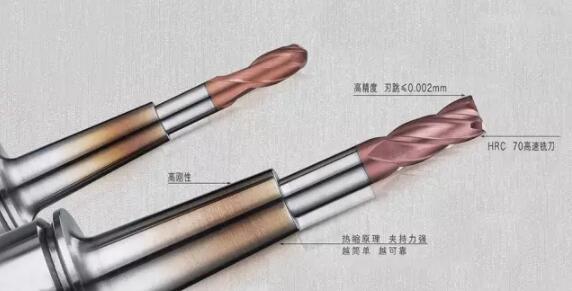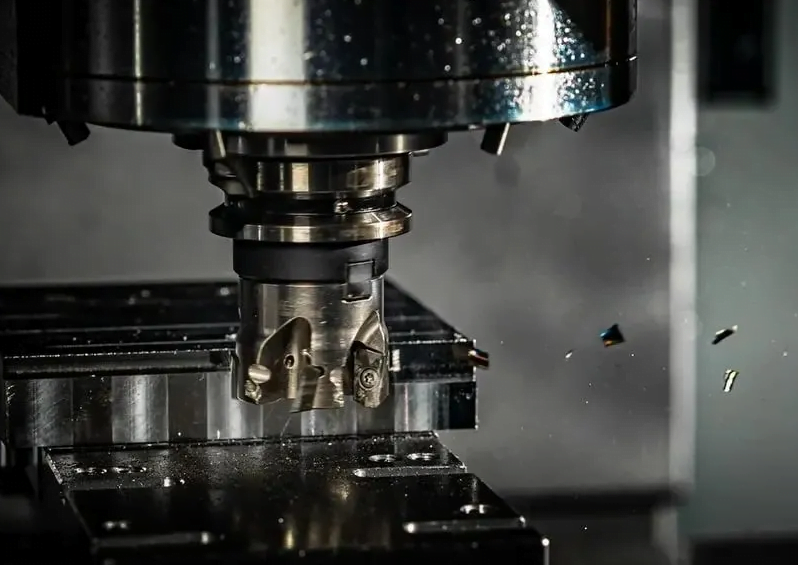In the CNC cutting process, the causes of machining errors are many, the error caused by the radial runout of the tool is one of the important factors, it directly affects the machine tool in the ideal processing conditions can achieve the minimum shape error and the geometric shape of the machined surface accuracy. In practice, the radial runout of the tool affects the machining accuracy of the part, the surface roughness, the unevenness of the tool wear and the cutting process characteristics of the multi-tooth tool. The greater the radial runout of the tool, the more unstable the machining state of the tool, the more it affects the processing effect.

▌ Causes of radial runout
Tool and spindle components manufacturing errors, clamping errors caused by drift and eccentricity between the tool axis and the ideal axis of rotation of the spindle, as well as specific machining processes, tooling, etc. may produce radial runout of CNC milling machine tools in the processing.
- The impact of the radial runout of the spindle itself
The main reasons for the radial runout error of the spindle are the coaxiality error of each journal of the spindle, the various errors of the bearing itself, the coaxiality error between the bearings, the spindle deflection, etc., their impact on the radial rotation accuracy of the spindle size with the different processing methods and different. These factors are in the manufacturing and assembly of machine tools and other processes formed, as the operator of the machine tool is difficult to avoid them to bring the impact.
- Influence of inconsistency between tool centre and spindle centre of rotation
In the process of mounting the tool to the spindle, if the centre of the tool and the centre of rotation of the spindle do not coincide, it will inevitably also bring about the radial runout of the tool. The specific influencing factors are: the fit of the tool and the collet, the correct method of loading the tool and the quality of the tool itself.

- Influence of specific machining processes
Radial runout of the tool during machining is mainly due to radial cutting forces that exacerbate radial runout. The radial cutting force is the radial component of the total cutting force. It deforms the workpiece and generates vibrations during machining, and is the main force that affects the quality of the workpiece. It is mainly affected by the cutting amount, tool and work piece material, tool geometry angle, lubrication method and processing method and other factors.
▌ Method of reducing radial runout
The tool produces radial runout during machining mainly because the radial cutting force aggravates the radial runout. Therefore, reducing the radial cutting force is an important principle to reduce radial runout. Several methods can be used to reduce radial runout as follows.
- Use sharp tools
Choose a larger tool front angle to make the tool sharper to reduce cutting forces and vibration. Choose a larger tool back angle to reduce the friction between the main and rear tool faces of the tool and the elastic recovery layer of the workpiece transition surface, which can reduce vibration. However, the front and rear angles of the tool should not be chosen too large, otherwise it will lead to insufficient strength and heat dissipation area of the tool. Therefore, different front and rear angles of the tool should be used in conjunction with the specific situation, which can be smaller for rough machining, but should be larger for the purpose of reducing the radial runout of the tool during finishing, so that the tool is sharper.
- Use stronger tools
The strength of the tool can be increased in two main ways. One is to increase the diameter of the toolholder. If the toolholder diameter is increased by 20%, the radial runout of the tool can be reduced by 50% under the same radial cutting force. Second, you can reduce the tool extension length, the greater the tool extension length, the greater the tool deformation during processing, processing in constant change, the radial runout of the tool will change, resulting in the workpiece processing surface is not smooth Similarly, the tool extension length is reduced by 20%, the radial runout of the tool will also be reduced by 50%.
- The front face of the tool should be smooth
During machining, a smooth front face reduces the friction of the chip on the tool and also reduces the cutting force on the tool, thus reducing the radial runout of the tool.
- Spindle taper bore and collet cleaning
The spindle taper bore and collet should be clean and free from dust and residual chips from the machining of the workpiece. When choosing a machining tool, try to use a tool with a short extension length when tooling up, the strength should be reasonable and even, not too big or too small.
- The selection of the amount of tool eating should be reasonable
The amount of tool eating is too small, there will be processing slippage phenomenon, which leads to the continuous change of the radial runout of the tool in the processing, so that the processed surface is not smooth when the amount of tool eating is too large, the cutting force will increase, which leads to a large deformation of the tool, increasing the radial runout of the tool in the processing, will also make the processed surface is not smooth.
- Using reverse milling in finishing
As the clearance position between the screw and nut is changing when milling, it will cause uneven table feed, thus having impact and vibration, affecting the machine tool, tool life and surface roughness of the workpiece while using reverse milling, the cutting thickness changes from small to large, the tool load also changes from small to large, the tool is smoother when processing. Note that this is only used when finishing, when rough machining is carried out or to use the smooth milling, this is because of the high productivity of the smooth milling, and the tool life can be guaranteed.
- Proper use of cutting fluids
The proper use of cutting fluids is based on the cooling effect of the water solution has little effect on the cutting force. Cutting oil with a lubricating effect can significantly reduce cutting forces. Due to its lubricating effect, it can reduce the tool front surface and chip between and after the tool surface and the workpiece transition surface between the friction, thereby reducing the radial runout of the tool.
Practice has proved that, as long as to ensure the accuracy of all parts of the machine tool manufacturing, assembly, selection of reasonable technology, tooling, the radial runout of the tool on the workpiece machining accuracy of the impact can be minimised.












